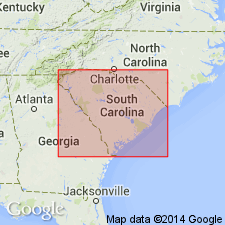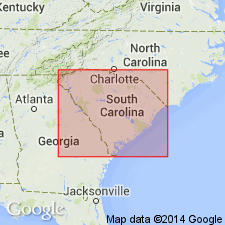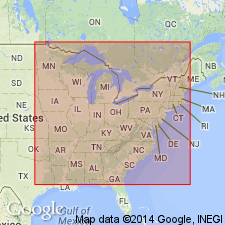
- Usage in publication:
-
- Richtex Formation
- Modifications:
-
- Named
- Dominant lithology:
-
- Slate
- Phyllite
- AAPG geologic province:
-
- Piedmont-Blue Ridge province
Summary:
Named Richtex Formation for slate and fine-grained phyllite with turbiditic mudstone origin. In some localities the unit contains andesite and basaltic tuff in its lower part. The age of the Richtex is considered to be Late Precambrian or Cambrian.
Source: GNU records (USGS DDS-6; Reston GNULEX).

- Usage in publication:
-
- Richtex Formation
- Modifications:
-
- Overview
- AAPG geologic province:
-
- Piedmont-Blue Ridge province
Summary:
Richtex Formation is predominantly composed of thin-bedded to massive mudstone and wacke interlayered with mafic tuffs and flows and intruded by sheets and plugs of epizonal mafic igneous rock. Probably a turbidite deposited below wave base. Unit is widespread in the slate belt of central and western SC. Contact with underlying Persimmon Fork Formation is either an unconformity or a fault. Richtex is not a lateral facies equivalent of the Asbill Pond formation (informal) as the contact between the Asbill Pond and the Persimmon Fork in the Batesburg, Emory, and Johnston quads. is conformable. The age of the Richtex is in question. If it is faulted over the Persimmon Fork, it may be as old as Late Proterozoic. If the contact is an unconformity it must be younger than Middle Cambrian, but no Paleozoic fossils have been found in the Richtex so far.
Source: GNU records (USGS DDS-6; Reston GNULEX).

- Usage in publication:
-
- Richtex Formation*
- Modifications:
-
- Overview
- AAPG geologic province:
-
- Piedmont-Blue Ridge province
Summary:
On the correlation chart for Precambrian rocks of the conterminous United States, the Richtex Formation in the Carolina Slate Belt of the Avalonian terranes is shown to be of Early and Middle Cambrian age.
Source: GNU records (USGS DDS-6; Reston GNULEX).
For more information, please contact Nancy Stamm, Geologic Names Committee Secretary.
Asterisk (*) indicates published by U.S. Geological Survey authors.
"No current usage" (†) implies that a name has been abandoned or has fallen into disuse. Former usage and, if known, replacement name given in parentheses ( ).
Slash (/) indicates name conflicts with nomenclatural guidelines (CSN, 1933; ACSN, 1961, 1970; NACSN, 1983, 2005, 2021). May be explained within brackets ([ ]).

